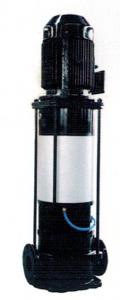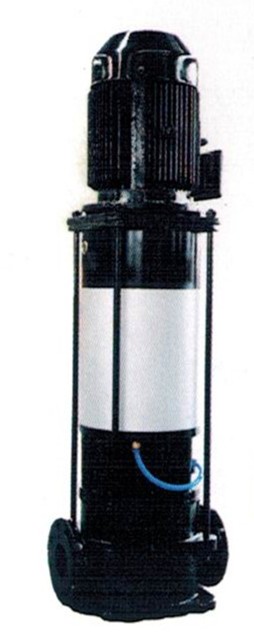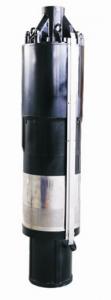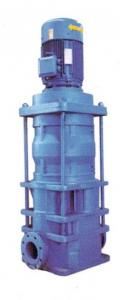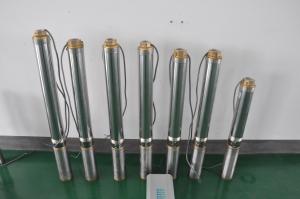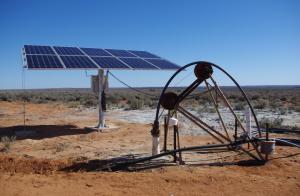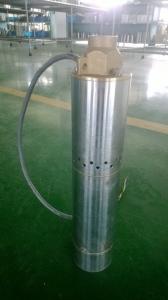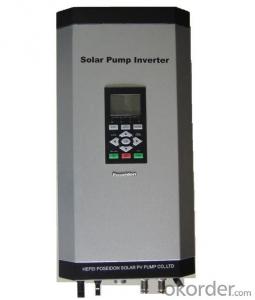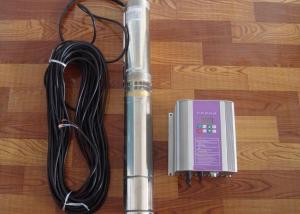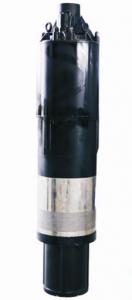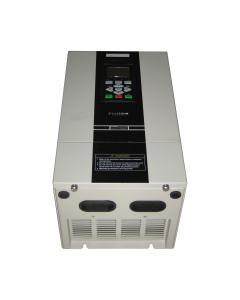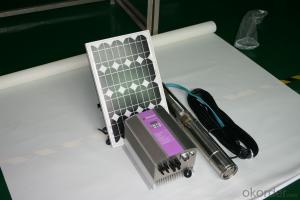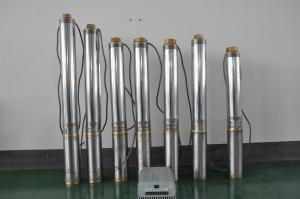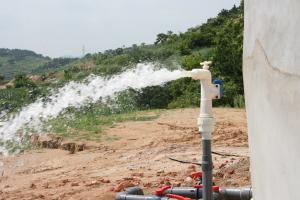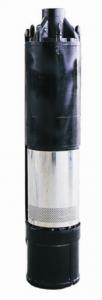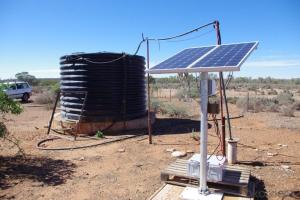Solar Pump Well L3D-10-180
- Loading Port:
- China Main Port
- Payment Terms:
- TT OR LC
- Min Order Qty:
- -
- Supply Capability:
- 300 sets /month
OKorder Service Pledge
OKorder Financial Service
You Might Also Like
Product description:
Product: Solar water pump
Model:L3D-10-180
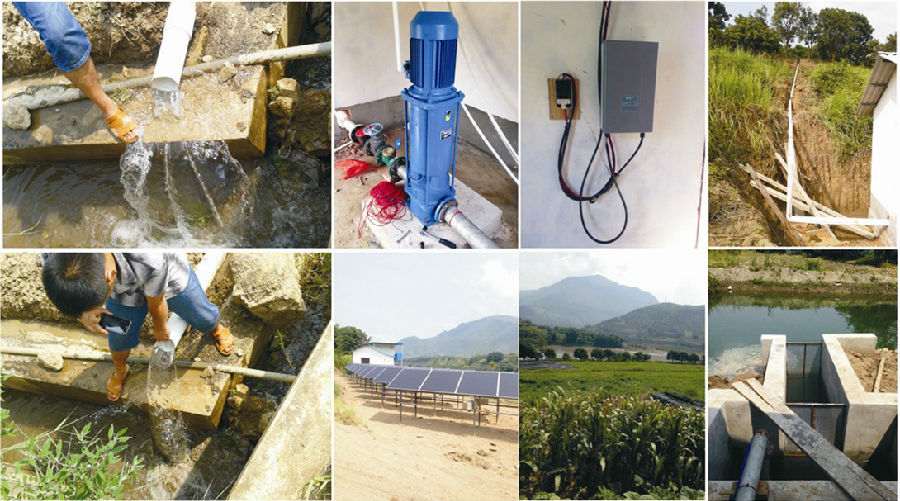
Appilication:
surface pump
for surface water of pond, river, lake
for irrigation of a big farm with 6000 m2 on the top of a small mountain
Product specification:
flow rate:10m3/ hour, 80m3/day.
lift: 10m-180m
pump diameter: 296mm
Pump installed on the ground, outlet to the water surface:4m
with AC motor, motor power:5.5kW
but only need solar power:3.2kW(while Grundfos pump needs at least 11.5kW solar power, our pump can save more than 50% solar panel power,save USD3600 cost for solar panel per set.
Material:
Pump inside: stainless steel and wearable nylon,it enables our solar pump to have 10 years sevice life.
Motor : AC motor, 380V , three phase , 50Hz. The pump also can connect with grid power directly.
Certification:
3 International patent
ISO9001
CE
Warranty:2 years
- Q: How do I calculate the solar energy required for running a solar pump?
- To determine the solar energy needed to operate a solar pump, several factors must be taken into account: 1. Find out the power consumption of the pump by checking its wattage rating. This information is typically available in the pump's specifications or user manual. 2. Estimate the daily energy usage by multiplying the pump's power rating by the number of hours it operates each day. For instance, if the pump has a rating of 500W and runs for 4 hours, the daily energy consumption would be 500W x 4 hours = 2000 watt-hours (Wh) or 2 kilowatt-hours (kWh). 3. Consider efficiency losses since solar panels are not 100% efficient. It is generally assumed that solar panels have an efficiency of 70-80%. To account for this, divide the daily energy consumption (calculated in step 2) by the assumed panel efficiency. For example, if the daily energy consumption is 2 kWh and the assumed panel efficiency is 75%, the required solar energy would be 2 kWh / 0.75 = 2.67 kWh. 4. Take into account solar insolation, which refers to the amount of solar radiation received per unit area in a specific timeframe. Solar insolation varies based on location and time of year. Use local weather data or conduct research to determine the average daily solar insolation for your area. This information is typically given in kilowatt-hours per square meter per day (kWh/m²/day). 5. Calculate the necessary solar panel capacity by dividing the required solar energy (from step 3) by the average daily solar insolation (from step 4). For instance, if the required solar energy is 2.67 kWh and the average daily solar insolation is 5 kWh/m²/day, the required solar panel capacity would be 2.67 kWh / 5 kWh/m²/day = 0.534 square meters (or 534 square centimeters). Bear in mind that this calculation provides an estimate, and actual results may vary due to factors like shading, panel orientation, and efficiency variations. It is advisable to consult a solar energy professional or supplier for a more accurate assessment tailored to your specific needs.
- Q: Do solar pumps need batteries to operate?
- No, solar pumps do not need batteries to operate. They use solar energy directly to power the pump and do not require any additional storage or backup systems.
- Q: Can a solar pump operate at night?
- No, a solar pump cannot operate at night as it requires sunlight to generate power and function.
- Q: Can a solar pump be used to fill a water storage tank?
- Yes, a solar pump can be used to fill a water storage tank. Solar pumps use solar energy to power the pump, allowing it to draw water from a source such as a well or a river, and then pump it into a storage tank. This is an environmentally-friendly and cost-effective method of filling a water storage tank, as it eliminates the need for electricity or fuel to power the pump. Additionally, solar pumps can be used in remote areas where access to electricity may be limited or nonexistent.
- Q: How does a solar pump handle water with high levels of sand or other abrasives?
- A solar pump with high levels of sand or other abrasives typically has a built-in filtration system to prevent clogging. This system helps separate the sand or other particles from the water, ensuring smooth operation and reducing the risk of damage to the pump.
- Q: Can a solar pump be used for water supply in a remote cabin?
- Yes, a solar pump can be used for water supply in a remote cabin. Solar pumps are designed to operate using solar energy, making them an ideal choice for off-grid locations like remote cabins. They can effectively pump and deliver water from a well, river, or other water sources, providing a reliable and sustainable water supply for the cabin.
- Q: Can a solar pump be used in public parks for water features?
- Yes, solar pumps can be used in public parks for water features. Solar pumps are an environmentally friendly and cost-effective option for powering water features in outdoor spaces like public parks. They can provide a sustainable and reliable source of energy to power fountains, waterfalls, or other water features, reducing the need for electricity from the grid and minimizing the carbon footprint of these installations. Additionally, solar pumps can operate independently, making them an ideal choice for remote or off-grid locations, ensuring that public parks can have visually appealing water features without relying on traditional power sources.
- Q: Are there any limitations to the temperature of the water a solar pump can handle?
- Yes, there are limitations to the temperature of the water that a solar pump can handle. Most solar pumps are designed to handle water temperatures up to a certain limit, typically around 60-70 degrees Celsius (140-158 degrees Fahrenheit). Exceeding this temperature can potentially damage the pump's components and reduce its efficiency. It is important to ensure that the water temperature remains within the specified range to ensure the proper functioning and longevity of the solar pump.
- Q: How do you maintain a solar pump?
- To guarantee the efficiency and longevity of a solar pump, it is crucial to maintain it properly. Here are a few essential steps to take: 1. Keep the solar panels clean and free from dust, debris, or grime that could hinder their performance. Use a soft brush or cloth to gently clean them, avoiding harsh chemicals or abrasive materials that may scratch the surface. 2. Inspect and secure all connections, cables, and wiring to ensure they are tightly secured and undamaged. Loose connections can lead to power interruptions or reduced efficiency. Also, check the solar pump controller and inverter for any signs of wear or malfunction. 3. Monitor the pump's performance regularly to detect any changes or irregularities. Pay attention to the flow rate, pressure, and any unusual noises. If any issues arise, troubleshoot and address them promptly to prevent further damage. 4. If your solar pump has a battery, it is essential to monitor and maintain its health. Regularly check the battery's charge level and ensure it stays within the recommended range. Additionally, clean the battery terminals and prevent corrosion. 5. Protect the system from extreme weather conditions that can impact its performance. During winter, insulate exposed parts or drain the water from the pump to prevent freezing. In storm or hail-prone areas, consider installing protective covers or shields to safeguard the panels and other vulnerable components. 6. Schedule routine inspections of the solar pump system, following the manufacturer's recommendations. Thoroughly check all system components, including the pump, panels, wiring, and controller. If unsure about any maintenance tasks, consult a professional or contact the manufacturer for guidance. By adhering to these maintenance practices, you can ensure that your solar pump operates optimally, providing reliable and efficient water pumping for many years to come.
- Q: How to use solar panels to drive 50W of circulating water pump, what configuration needs, how to connect?
- Stable, you must control the output of the battery, try to use a peak 30V-36V, peak current 2A-3.5A battery power supply, so even if it is cloudy, the battery will output at least 1.5-2A, according to you
Send your message to us
Solar Pump Well L3D-10-180
- Loading Port:
- China Main Port
- Payment Terms:
- TT OR LC
- Min Order Qty:
- -
- Supply Capability:
- 300 sets /month
OKorder Service Pledge
OKorder Financial Service
Similar products
Hot products
Hot Searches
Related keywords
